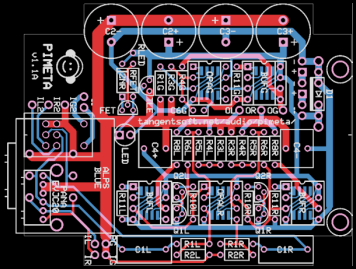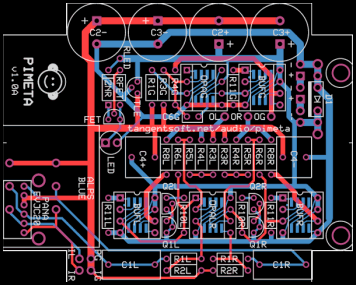Project History and Acknowledgements
The META42 boards became available in June 2002, but just 6 months later Intersil discontinued the buffer that the design depends on. I (tangent) made a large final purchase of these buffers so we could keep offering this fine combination. All good things must come to an end: about 9 months later my buffer stock ran low enough that I stopped offering the parts for this amp.
While all this was happening, I was working with others on the PPA project. (See its History page for details). When it came time to replace the META42, morsel and I decided to try making a PPA-like topology amp in a board size similar to that of the META42. We succeeded, though the board did have to be enlarged slightly, so that it no longer fits into PacTec HML cases.
Our main problem was justifying the higher cost of this next generation design vs. the META42. The BUF634 costs 75% more than the EL2001, and to at least our ears the EL2001 sounds better. By moving to a PPA-like topology, we add even more to the cost in the form of an additional single-channel op-amp. Obviously we had no choice about the move to the BUF634, so the question was whether the PPA-like configuration was worth its higher parts cost. We decided to make prototypes of both designs and run them off against each other. The benchmarks said that both designs performed nearly identically from a measurement standpoint, but the real proof was in the listening. It’s not my place to review the sound here, so let me simply say that I was pleased to find that there are readily audible differences between the two designs, and that the PPA-like topology’s sound pleased me more.
Version History
Version 1.1, 2004.11.02:

|
- Added pads for ALPS RK097 and RK098 series pots. (Not RK09D or
RK09K!)
- Thickened ground bus from 60 mil to 100 mil in most places.
- Rerouted V- line between OPAG and BUFG so that it doesn’t go
through OPAG pin 5. Allows use of OPA6[23]7 here without lifting pin
5.
- Reordered rail caps so that C2s and C3s are next to each other,
allowing you to use just the rearmost pair (C3s, now) to make room
near front of board for big panel components.
- Nudged some parts around to achieve the above goals.
- Straightened trace from R2L to R1L.
Version 1.0, 2003.10.06:

|
Besides the new topology and buffer, notable differences in the PIMETA v1.0 vs. the META42 v2.2 are:
- Ground bus is tree-like now, instead of a ring around the board
edge. Not quite a star ground, but close.
- You have to cut a trace under C1 if you to add it to get an
AC-coupled amp.
- C1 position is smaller now.
- There is no R7, since the BUF634 has input resistance already.
- Added a bandwidth resistor (R11) to each BUF634.
- Rearranged the pots once again. Only Panasonic EVJ and ALPS RK27
pots are supported.
- The board is 0.1" longer, and the rear shoulder was moved out slightly (0.05"?) as well. This allows room for the R11s and the space between the C2/C3s.
What Does the Acronym Stand For?
It’s a PPA-Inspired META42 successor.
If you don’t like it, feel lucky...it was almost called the PIMENTO. Luckily I couldn’t think of a good expansion for that.
Acknowledgements
The idea to move to a PPA-like design was probably initially proposed by morsel. As I recall, I went and did the initial PIMETA design work just to prove to her that it couldn’t be done. :) I don’t know whether to feel smug or chagrined.
Pretty much the board as you see it was all my work, with some polishing by morsel. I did all the prototyping and initial testing. Naturally this design owes a lot to its predecessors, the META42 and the PPA. See those amp design’s History pages for the full accounting.